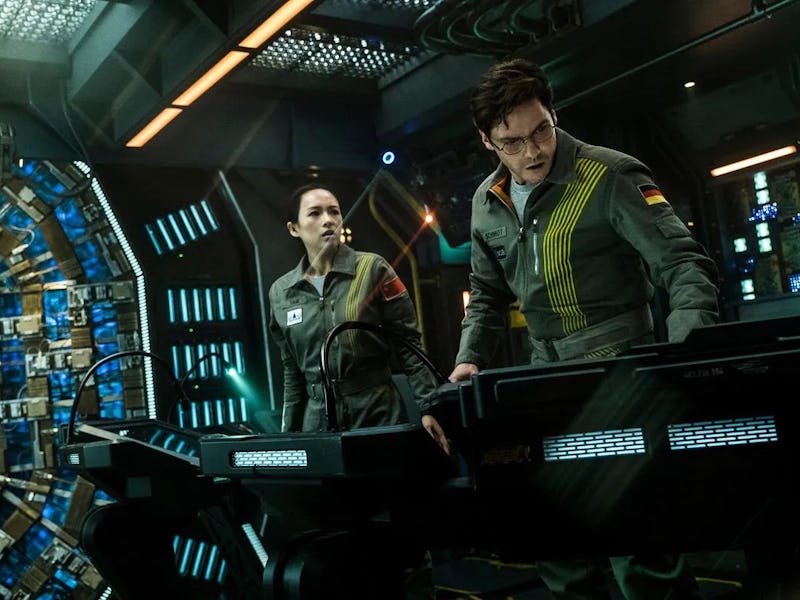A Failed Sci-Fi Sequel Stunt Accidentally Set the Standard for the Forgettable Netflix Movie
In 2018, Netflix announced a surprise release of The Cloverfield Paradox and killed a franchise.

The Cloverfield franchise was always a strange one. The first film essentially began as a proof of concept, a vehicle through which J.J. Abrams could test out a new monster and a new marketing technique for the viral age. There’s a reason the 2008 Cloverfield, directed by Matt Reeves, is remembered more for its viral marketing campaign — which used alternate reality games and Myspace to build hype — than for the film itself, though its found-footage approach did make a mark. But it was the surprise critical success of the second film, Dan Trachtenberg’s 10 Cloverfield Lane, that turned Cloverfield into a proper blockbuster franchise… until the next movie.
The thing about the Cloverfield franchise is that it’s basically Abrams’ infamous mystery box concept transformed into a movie-making machine. An independent screenplay would be developed under Abrams’ Bad Robot label, a rising filmmaker would get the chance to prove his mettle, and the film would get slapped with a “Cloverfield” label, instantly earning it buzz and intrigue. What did it matter what the movie was about? It had Abrams’ name attached, the cachet of a Cloverfield title, and most importantly, mystery. This would be any installment’s greatest strength, and ultimately The Cloverfield Paradox’s greatest curse.
The Cloverfield Paradox had a long, odd road to the screen. First announced in 2012 as The God Particle, the film was written by Oren Uziel and directed by Julius Onah, both relatively unknown. But the Bad Robot marketing machine worked its magic, and soon The God Particle became known as the “2017 Cloverfield movie,” gaining a cast that included the likes of Gugu Mbatha-Raw, Daniel Bruhl, Zhang Ziyi, Elizabeth Debicki, and David Oyelowo.
However, as the film neared its 2017 release date, a few wrenches were thrown into the works. Post-production was extended to add scenes that would make it a Cloverfield movie (Uziel revealed that he learned his film was to be a sequel during production, forcing him to rewrite scenes on the fly), and then Paramount dropped the film. Another little sci-fi film called Annihilation had cost the studio too much, and it was stung by the diminishing theatrical profits.
But Netflix would swoop in to buy it and, befitting the stunt-marketing nature of Cloverfield, pulled the franchise’s biggest stunt yet — the streaming service released it by surprise right after the Super Bowl. In doing so, Netflix would intentionally, and unintentionally, set the template for each of its big original releases going forward.
The intentional: the big hype upfront, where everyone tuned in and talked about the film for a total of maybe 24 hours. The unintentional: a totally middling, forgettable movie gets lost in the recesses of the streaming dustbin. With The Cloverfield Paradox, Netflix accidentally set the standard for the forgettable overhyped Netflix potboiler — your Gray Men, your Red Notices — which managed to “break” streaming records, only to leave everyone’s minds immediately. At the time, it felt like an anomaly, but now it’s become the norm.
Gugu Mbatha-Raw is wasted in The Cloverfield Paradox.
I remember tuning into the Super Bowl to watch the Cloverfield Paradox trailer, and the mad rush to watch the film itself and figure out coverage the next day. I also remember the feeling of sinking disappointment as The Cloverfield Paradox revealed itself to be the worst thing that a sci-fi sequel could be: boring. It felt like such a waste of a ridiculously talented cast to have them spend the majority of their screen time standing around sci-fi corridors arguing, or staring at screens of Cloverfield-connected news reports that were definitely inserted in post-production.
The premise is interesting enough: an international crew of experts has assembled to test a snazzy new particle accelerator in space and hopefully solve a worldwide energy crisis. When the test works, it accidentally sends them to another dimension, where they discover a screaming woman in the walls (Debicki) and are picked off one by one by strange space-time anomalies.
Daniel Bruhl screaming about the injustice of the Cloverfield franchise.
However, the premise is less interesting once you realize that it’s essentially a Marvel-ized Event Horizon, with less eye trauma and no good villain to make it fun. It didn’t help that the Cloverfield references were all obviously jammed in. The event that sends them to an alternate dimension is ham-fistedly called “The Cloverfield Paradox,” while the excruciating B-plot of an Earth under attack by a mysterious “thing” slows the pace down to a grinding halt. It’s a shame, because there are some interesting elements in there about grief and guilt, mostly embodied by Mbatha-Raw’s tortured comms officer Ava. But they get buried underneath the Cloverfield of it all.
Now the Cloverfield Paradox exists as a failed stunt, a disappointment that killed a franchise and inadvertently paved a path for future forgettable Netflix movies. In an alternate timeline where it opened in theaters without the weight of another franchise attached, maybe it would have been less of a fascinating failure. Instead, the only paradox worth considering is trying to determine what the hell the marketing department was thinking.
The Cloverfield Paradox is streaming on Netflix.